Ireland’s Ancient Ruins: Unveiling the Mysteries of Celtic Legacies!
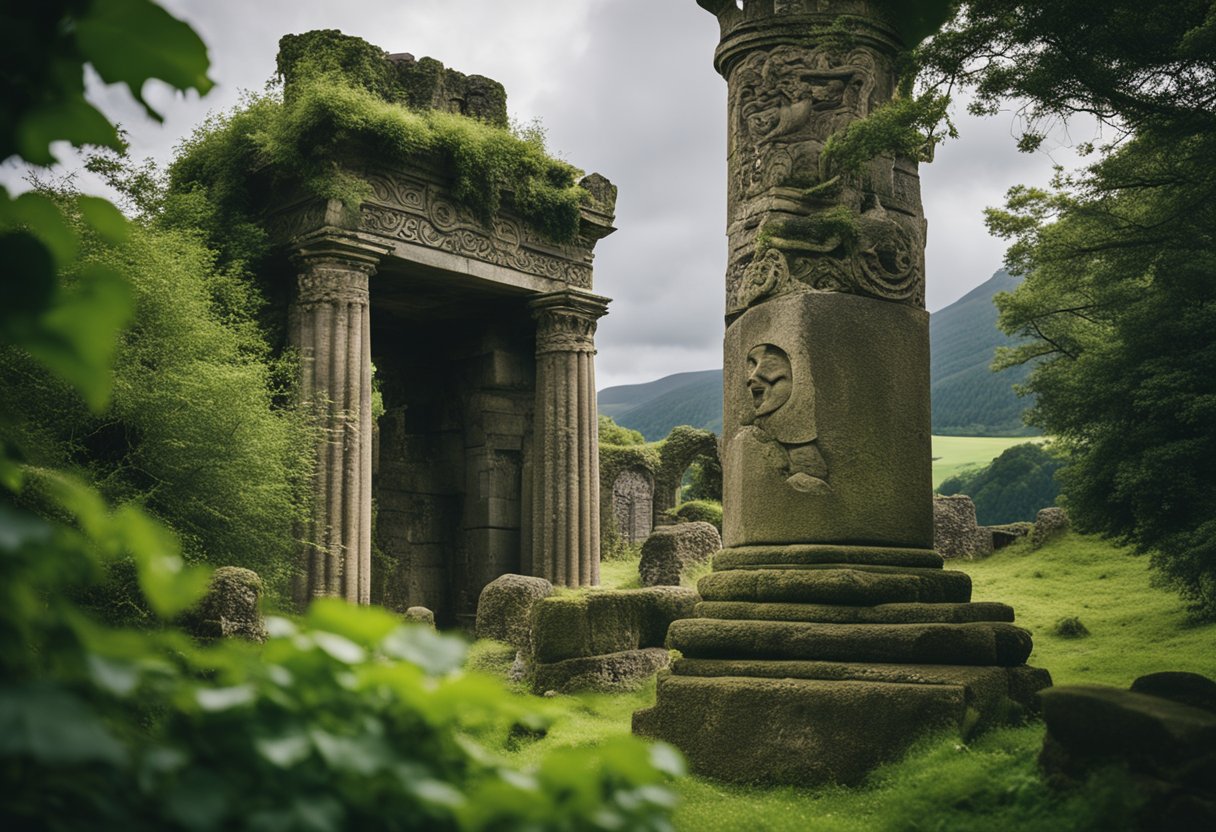
Updated On: April 23, 2024 by Esraa Mahmoud
Traversing the verdant landscapes of Ireland takes you to another realm where history and mythology reign supreme. Ireland’s ancient ruins are time capsules that allow us to peer into an era when mythical heroes walked the land and early Christian and pre-Christian societies thrived.
These structures, ranging from towering stone forts to solemn monasteries, stand as silent guardians of the past, offering a tangible connection to the island’s storied heritage. They bear witness to Ireland’s transformation across countless generations, from the time of the Celtic tribes to the advent of Christianity and beyond.
Indeed, these ruins do not merely dot the countryside; they are interwoven into the very fabric of Irish identity. Each ruin, be it the legendary Hill of Tara with its kingship lore or the mysterious stone circles with untold ritualistic significance, tells a part of Ireland’s narrative.
They invite modern explorers to unearth the layers of myth and history that have shaped this nation. As we walk amidst these remnants of bygone epochs, we decrypt tales of Irish kings, mythical heroes, and the powerful forces of nature and spirituality that sculpted a uniquely Irish worldview. So, let’s find out more about the magestic Ireland’s ancient ruins.
Ireland’s Ancient Ruins Landscape and Sites
Ireland’s lush greenery and rugged landscapes are home to some of the most significant Neolithic and Bronze Age structures in the world. We find these cultural markers sprinkled across the countryside, from the serene Wicklow Mountains to the dramatic coastlines of the Wild Atlantic Way.
Newgrange, in the heart of the Boyne Valley, stands as a testament to Ireland’s rich prehistoric past. It is a prehistoric monument dating back over 5,000 years, making it older than Stonehenge and the Egyptian pyramids. This passage tomb is renowned for its astrological alignment, with its chamber illuminated by the winter solstice sunrise.
Just south of Dublin, in a valley of serenity, lies Glendalough. This early monastic settlement was founded in the 6th century and exudes a sense of peace and timelessness amidst its ancient ruins.
The following table lists some key ancient sites along with their estimated date ranges and significance:
| Site Name | Date Range | Cultural Period | Significance |
|---|---|---|---|
| Newgrange | c.3200 BC | Neolithic | Solar alignments, Passage tomb |
| Glendalough | 6th Century AD | Early Medieval | Monastic settlement, Christian heritage |
| Boyne Valley | Neolithic – Iron Age | Neolithic to Iron Age | Concentration of megalithic art and tombs |
The topography of Ireland is scattered with standing stones and other megaliths, reminders of a distant prehistoric past. Many of these enigmatic stone structures were built during the Bronze Age and Iron Age, reflecting different aspects of ritual and social life.
These ancient sites serve both as historical landmarks and pathways to understanding the early history of the Emerald Isle. Each stone and every ruin tells a story; collectively, they narrate the tale of a land steeped in myth and history.
The Mythological Tapestry of Ireland
Ireland’s ancient ruins are not mere relics of stone and mortar; they are the woven threads of a vibrant mythological tapestry that adorns the land. These time capsules narrate a rich canvas of Irish myths and legends where the mystical intersects with the historical.
A good example of these myths is the Tuatha Dé Danann. Often central to Ireland’s mythological stories are the Tuatha Dé Danann, a race of god-like beings skilled in magic and mastery over natural forces. They stand as emblematic figures within the Mythological Cycle of Ireland, embodying the essence of pre-Christian Ireland’s beliefs.
Interwoven with these supernatural narratives are tales of legendary High Kings. Stories of rulers like Eber Finn and Conn of the Hundred Battles blur the lines between legend and reality, leaving a legacy etched in both folklore and fact.
In any journey through these ruins, you will encounter vestiges of the past, such as passage tombs and ceremonial sites. For instance, the Great Mound at Knowth is an architectural marvel that speaks to the ingenuity of ancient civilisations and the complex belief systems that guided them in both life and the afterlife.
Lastly, the enduring allure of fairies, often referred to in Gaelic as “Aos Sí,” persists in Irish culture. These ethereal beings flutter through stories connecting us to the natural world and the enigmatic realms beyond.
Through visiting these ancient sites and delving into the stories they hold, you will uncover not only Ireland’s history but also its soul—a narrative tapestry rich with magic, mythology, and the echo of kings long passed.
Historic Epochs and Their Monuments
Ireland’s landscapes are studded with monuments, each a testament to the epochs they represent. From the Neolithic to the Iron Age, these structures form a narrative of Ireland’s past.
Neolithic (c. 4000–2500 BC): The ancestors left behind an impressive array of passage tombs, such as the renowned Brú na Bóinne. These tombs, alongside other megalithic structures, reflect advanced knowledge of construction and celestial alignments.
Bronze Age (c. 2500–500 BC): During this period, communities erected imposing stone circles and burial cairns. Their artefacts, rich in history, suggest a society adept in metallurgy and craftsmanship.
Iron Age (c. 500 BC–400 AD): This era saw the emergence of hillforts and promontory forts dotting the landscape. The Iron Age remained enigmatic but is often romantically linked to the tales of the Tuatha Dé Danann and the emergence of Celtic culture.
Early Christian Period (400–1169 AD): Characterised by iconic high crosses and round towers, these ecclesiastical sites exemplify the fusion of faith and artistry. The creation of the Book of Kells, a masterpiece of religious illumination, symbolises this time’s cultural zenith.
Romanesque Period (Late 11th–Late 12th Century): The introduction of Romanesque architecture is captured in the heavy stonework and round arches of the era’s churches and cathedrals, many of which stand to this day.
Significant Ancient Structures
Ireland is home to some of the most remarkable ancient structures, each holding stories of a bygone era. These monuments are not only architectural feats but also serve as time capsules, preserving myths and history.
Hill of Tara
Once the ancient seat of power in Ireland, the Hill of Tara in County Meath is an emblematic site. It comprises numerous ancient monuments, including the Lia Fáil, or “Stone of Destiny,” where kings were once inaugurated.
Rock of Cashel
Dominating the landscape with its impressive silhouette, the Rock of Cashel in County Tipperary is a historic site featuring a unique mix of ecclesiastical ruins from different periods.
Glendalough
In the heart of the Wicklow Mountains National Park rests Glendalough, a sixth-century monastic settlement. Its round tower overlooks the valley, serving as a resilient symbol of monastic life in Ireland.
Clonmacnoise
By the River Shannon lies Clonmacnoise, an early Christian site renowned for its high crosses, cathedral, and collection of ecclesiastical remains. Its strategic location has made it a centre for religion, learning, craftsmanship, and trade.
Loughcrew
The Loughcrew cairns, over 5,000 years old, are a group of Neolithic passage tombs in County Meath. They hold significance for their megalithic art and alignments with the equinoxes.
Lastly, over in County Armagh is Navan Fort, an ancient ceremonial monument, which, according to tradition, was one of the great royal sites of pre-Christian Gaelic Ireland.
Together, these ancient structures offer a profound insight into Ireland’s rich and complex history. Each site is a testament to the ingenuity and spirituality of the people who built them and lived within their shadows.
Famous Lore-Filled Locations
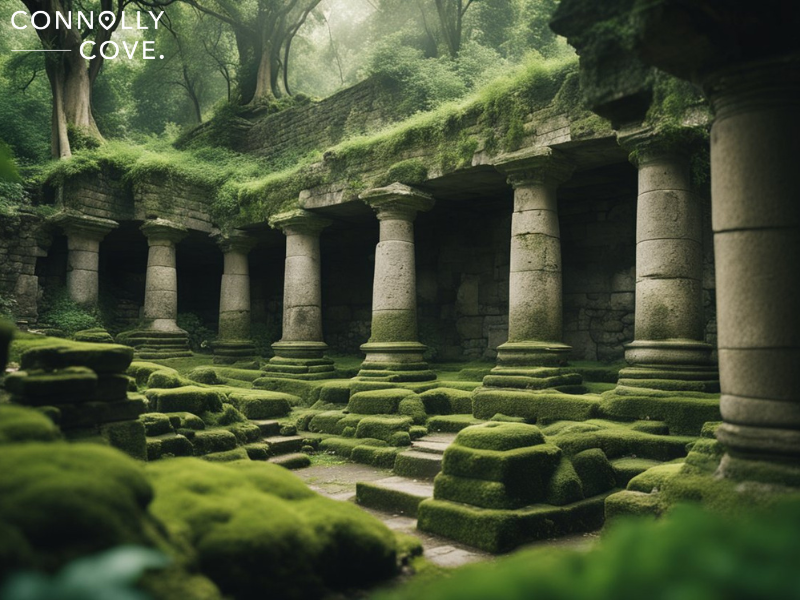
Ireland is filled with ancient sites steeped in lore and history. County Meath, the land of the High Kings, is rich with myth. The Hill of Tara, for instance, was once the political and spiritual centre of Celtic Ireland. It’s a place where legends come alive, whispering tales of ancient kings and mystical rites.
Moving to County Waterford, we find the ancient city of Waterford. It was founded by Viking settlers and holds onto a history that spans over a thousand years, which is evident in its unique urban landscape, which blends ancient Viking remnants and Norman constructions.
Glendalough lies in County Wicklow, known as the ‘Garden of Ireland’. This valley is famed not only for its stunning scenery but for its monastic history, with a monastic city that tells the tale of St. Kevin and his followers.
Another gem, Lough Gur in County Limerick, is a site encircled by myths and legends. This lake is surrounded by prehistoric remains and has been a place of worship and human activity for over 6,000 years.
Let us not forget County Sligo, often referred to as Yeats Country, where the landscape has inspired many of W.B. Yeats’ works. The mystic tableau of Benbulben, part of the Dartry Mountains, guards the land as if it were the sleeping giant of lore itself.
Celtic and Pre-Christian Ireland
In our exploration of Ireland’s ancient ruins, we must pay homage to the profound influence of Celtic and Pre-Christian societies. These civilisations laid the foundations for much of the island’s mythology and cultural traditions that endure to this day.
Celtic Ireland was not a homogenous entity but a tapestry of tribal societies that had spread their culture across much of Europe, arriving on Irish shores around 500 BC. They forged a new societal structure, supplanting the existing Bronze Age customs and leaving an indelible mark on Irish history. The iron-working Celts introduced a language that evolved into today’s Irish Gaelic and created intricate art famed for its patterns and symbols.
People still celebrate Samhain, which marks the Celtic New Year, a tradition transformed into modern Halloween. As the most significant festival, Samhain was a time when the veil between worlds was thinnest, rife with rituals and remembrance.
Sites like the Hill of Uisneach served as ceremonial and political centres. As the mythical heart of Ireland, it is where fires were lit during important festivals, symbolising the unity of the provinces.
Within this complex mythology, St. Patrick is a towering figure who transitioned Ireland to Christianity. Although best known for converting pagans, he also chronicled Druidic traditions, capturing a snapshot of a world on the cusp of transformation.
St. Brigid, another cherished saint, bridges the pagan and Christian eras, her history interweaving with the Celtic goddess of the same name. It reflects the syncretism between the two belief systems.
Christianity and Ancient Religious Sites
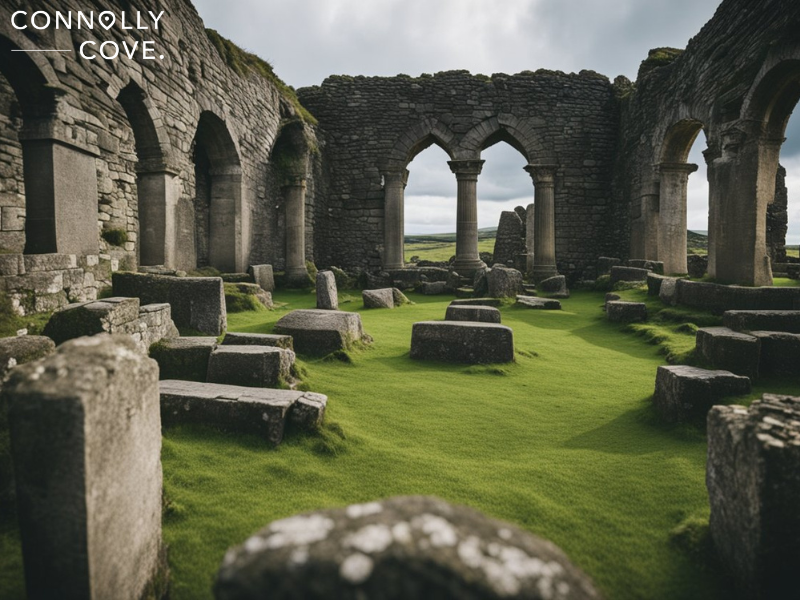
As we explore Ireland’s rich tapestry of history, it becomes clear that Christianity has played a pivotal role in the culture and landmarks of the region. From towering cathedrals to secluded monasteries, these places of worship stand as testaments to the faith that has shaped this nation for centuries.
Among the most iconic Christian sites in Ireland is Glendalough, founded by St. Kevin in the 6th century. A monastic settlement nestled in the heart of the Wicklow Mountains, its remains include an impressive round tower, which served both as a landmark and a place of refuge.
Ireland can also boast of illustrious cathedrals, with the likes of St. Patrick’s in Dublin honouring the patron saint of Ireland, St. Patrick, whose legacy in spreading Christianity is celebrated across the country.
In the county of Monaghan, the religious tradition is palpable in its early Christian sites, reflecting the resilience and devotion of past communities. Moving on to other poignant memorials of history, the Dunbrody Famine Ship offers a visceral connection to the hardships faced by those who sought to escape famine, often turning to their faith for solace during times of immense struggle.
Cultural and Spiritual Practices
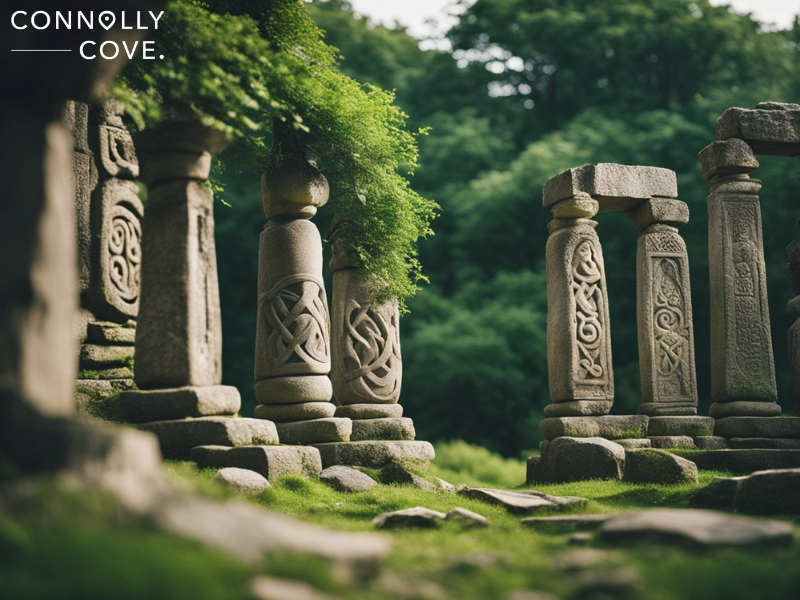
In excavating Ireland’s ancient roots, you will encounter a rich tapestry of cultural and spiritual practices. These practices, steeped in mythology and folklore, are vividly illustrated through the ruins scattered across the land. They serve as profound expressions of beliefs that have permeated Irish history.
Myth and spirituality were once intertwined with daily life, where fairies and witches emerged not just as fables but as entities with a symbolic presence that influenced communal rites and personal behaviours. Such beings were deeply ingrained within the cultural psyche, often invoked to explain the unknown or to illustrate moral lessons within local tales.
Samhain, known today as Halloween, exemplifies the convergence of the spiritual and the seasonal. It marked a pivotal time of year when the veil between worlds was at its thinnest, allowing for interaction with the supernatural. This period of celebration and caution heralded the end of the harvest and the onset of winter.
Moreover, figures like St. Brigid highlight the mingling of pagan traditions with Christian beliefs, exemplifying the adaptation of earlier practices into a Christian framework. St. Brigid’s alignment with the earlier goddess Brigid manifests the interweaving of Christianity with indigenous spirituality.
Archaeological Wonders and World Heritage
Some of the most significant Neolithic monuments in the world lie within the lush landscapes of Ireland. These testaments to ancient ingenuity provide an unparalleled window into prehistoric life. Among these is Newgrange, famed for its alignment with the Winter Solstice. As the sun rises on the shortest day of the year, its rays illuminate the inner passage, giving us a glimpse into our ancestors’ astronomical knowledge and cultural significance placed on celestial events.
Brú na Bóinne, a UNESCO World Heritage Site, encapsulates this region’s prehistoric grandeur. It includes not only Newgrange but also the impressive Knowth and Dowth tombs. These megalithic structures stand as engineering marvels, with Knowth housing the largest collection of Neolithic art in Western Europe.
The Boyne Valley offers more than just passage tombs. The Hill of Tara, once the seat of the High Kings of Ireland, brims with myth and legend, while the lesser-known Loughcrew harbours additional passage tombs rich in symbolism.
Finally, Navan Fort (Eamhain Mhacha) connects us to Celtic myth, once considered a royal fortress associated with the Ulster Cycle tales.
Modern Explorations of Ancient Ruins
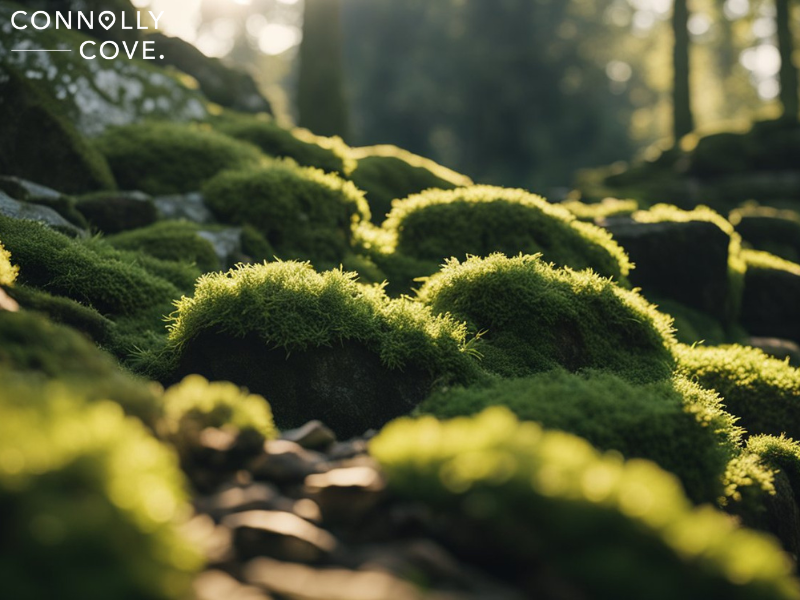
Venturing into Ireland’s Ancient East reveals a storybook of historic heartlands where visitors encounter the whispers of myth and history. Excursions typically begin in the Wicklow Mountains National Park, a verdant expanse that houses ancient monastic sites nestled among its peaks. Here, the art of modern exploration combines with reverence for the past as hikers tread lightly on trails carved by history.
In New Ross, the Dunbrody Famine Ship offers a poignant look at the emigrant experience, whilst a trip to Waterford leads us to the stoic Reginald’s Tower – Ireland’s oldest urban civic building. Meanwhile, Cobh serves as a gateway to voyages past, with its harbourside recalling legions of emigrants who departed its shores.
We can’t overlook the culinary charm of Cork, where the English Market buzzes with local fare and artisanal treasures, creating an inviting atmosphere for modern-day foragers. Meanwhile, those with a taste for heritage flock to the Smithwick’s Experience in Kilkenny to savour tradition in a pint.
Further tales unravel at Kyteler’s Inn, a medieval establishment where centuries of conviviality seep through its venerable walls. It’s in such locales that our connection to the past is deepened as they continue to forge new memories over hearty dishes and folklore.
Amid the rugged beauty of Cavan Burren Park, prehistoric landscapes meet contemporary interpretation, while the medieval charm of Carlingford lures us with its storied lanes and lough-side serenity.
In these explorations, you will get to traverse not just land but time itself, meshing modernity with the enduring essence of ancient Ireland. Each ruin, each relic, forms part of a continuum—a narrative that continues to shape with every footprint and every rediscovered story.
In conclusion, Ireland’s ancient ruins whisper tales of a rich and vibrant past. Exploring these sites is a chance to step back in time, connect with the deep roots of Irish culture, and ponder the mysteries of a bygone era.






